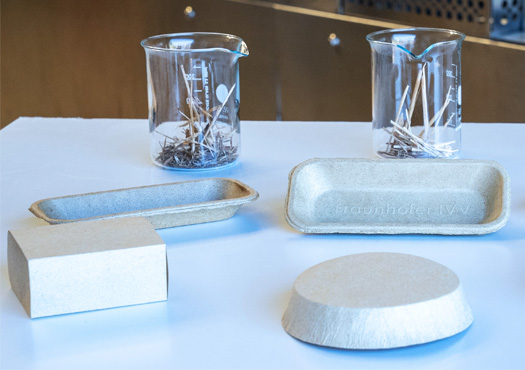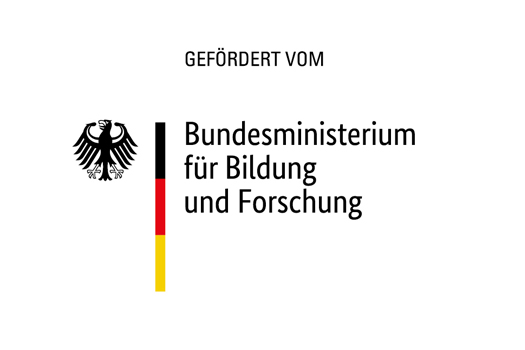Presentation of a decentralized value chain for paludicultures


Alternative, regional source of raw materials
For the agricultural or forestry use of rewetted peatlands (paludiculture), plant species that well tolerate high water levels well are used, such as reeds, cattail or reed canary grass. In particular, their significantly lower lignin content compared to wood and the fact that lignin is easier to extract from non-woody plants make these plants attractive for the production of pulp. This is because pulping processes can be used to prepare the raw materials, which require significantly less energy than paper production from wood. A lower lignin content also ensures that a more stable fiber network can form. In addition, pulp made from these plant fibers potentially has better mechanical properties than pulp made from other straw pulps, such as corn or bamboo.
As a regional raw material source, the use of paludicultures for packaging production offers several advantages in terms of climate protection and sustainability: the raw material generally has a better CO2 balance than conventional raw materials, agricultural greenhouse gas (GHG) emissions are reduced and the raw materials are renewable and biodegradable. The elimination of transportation routes saves resources and also contributes to the resilience of the packaging industry.
However, there is still a lack of understanding of the interactions between the raw material source, fiber properties and the technical implementation for the production of packaging. In addition, packaging made from paludicultures is still associated with additional economic costs compared to conventional raw materials. For this reason, the research project is developing a value chain for paludicultures for the production of paper and thermoformed or fiber-cast packaging demonstrators on a laboratory scale and investigating the use of paludicultures as an alternative raw material source for the production of paper packaging. The raw materials used for the investigations were reeds, reed canary grass and sedges.
Raw material preparation and production of the base material
The fiber material (reeds, reed canary grass and sedges) for the project was harvested by hand in Freisinger Moos in December 2022. In order to be able to process the raw materials, it was necessary to dry and reduce the length to a desirable length of one to four millimetres. The shorter the fibers, the more surface area is available for extraction and the better the biomass mixes in the reactor. However, if the fibers are too short, they are unsuitable for paper production, as fewer and more unstable fiber networks are formed and the mechanical and physical properties are not optimal.
A soda pulping process has been further developed for the preparation of raw materials and production of the whole pulp (including additives), which enables a 45% lower temperature and 11% less chemicals to be used than in conventional papermaking processes. The use of pressure vessels can also be dispensed with.
Paper sheet formation
In order to evaluate the sheet forming properties of paludic fibers for the production of paper and packaging, the mechanical properties (according to ISO 1924-1/2) were examined. The papers produced on a laboratory scale had a grammage of between 80 g/m2 and 88 g/m2 and a thickness of between 0.23 mm and 0.31 mm.
It was found that the strength values of a formulation made from 100 % paludicultures corresponded to those of commercially available papers of comparable grammage. At the same time, the addition of additives to improve the sheet formation properties of reed fibers was also investigated. Starch and sizing agents proved to be effective in increasing the tensile strength and extensibility of the papers.
The water absorption capacity (Cobb60 test according to DIN EN ISO 535) of the papers was also examined. The formulations made from 100 % paludicultures showed a very high water absorption capacity of 350 g/m2. This could also be reduced to approx. 25 g/m2 by adding additives, which is comparable to the Cobb60 values of commercially available coated papers.
Process for packaging production
Packaging demonstrators are used to analyze the potential of paludicultures for use in packaging applications. These are produced by means of fiber casting (rough fiber, thick wall and thin wall) and thermoforming. Previous results show that corresponding pulps can be processed very well into packaging using fiber casting and that these have higher strength properties than comparable packaging available on the market. Further investigations into thermoforming of corresponding papers and the influence on the mechanical properties to increase process stability, geometric fidelity and geometric variance will be carried out during the course of the project.
Prospects
Despite some challenges, the project results show that paludicultures can be a promising alternative for sustainable packaging solutions and are suitable for the production of folding boxes and trays. Further research and development is needed to fully exploit the potential of using bog plants for packaging production.
Project information
»Paludiverpackungen« is a research project of the Fraunhofer Initiative »Biogenic Value Creation and Smart Farming« and is funded by the Federal Ministry of Education and Research and the Bavarian State Ministry of Economic Affairs, Regional Development and Energy.
| Project duration: | January 2023 - April 2025 |
 Fraunhofer Institute for Process Engineering and Packaging IVV
Fraunhofer Institute for Process Engineering and Packaging IVV